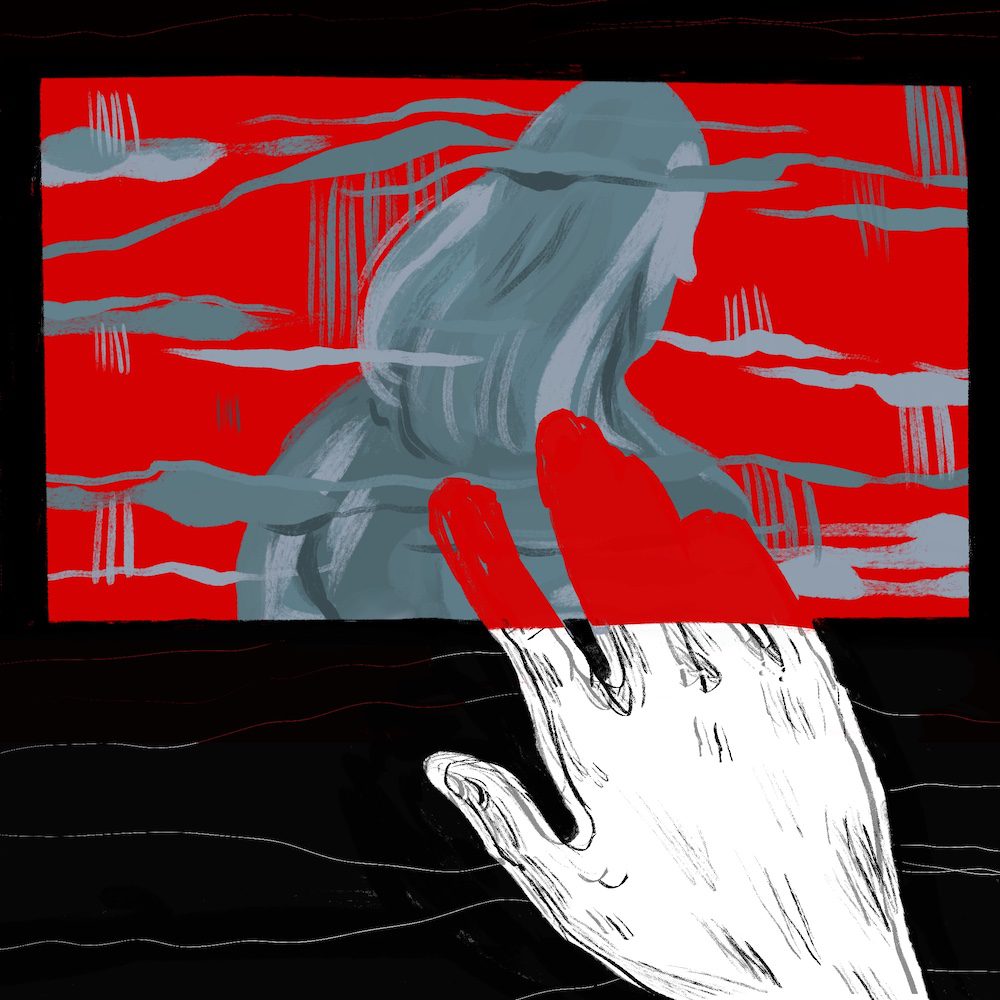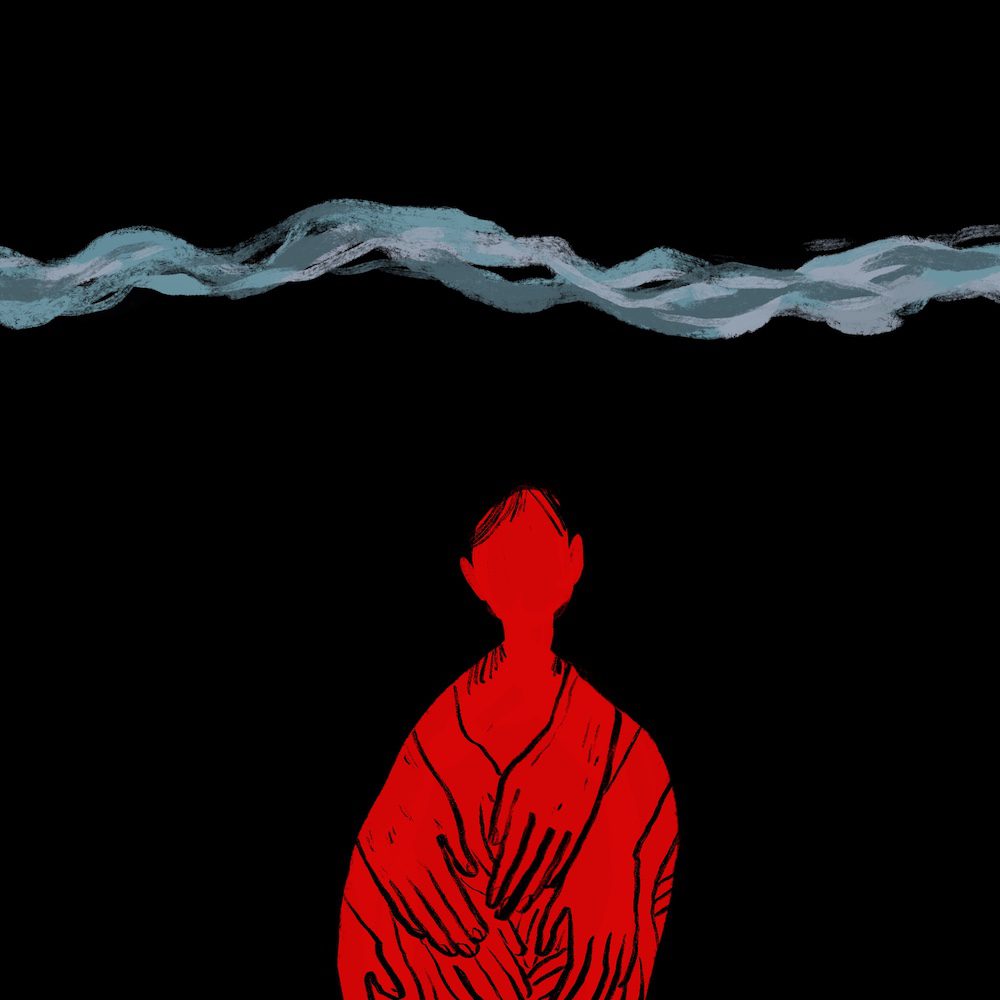The monster in Frankenstein believes that someone might want to help him, and it nearly gets him killed. The monster understands that he is unlike other people—he’s never seen any other eight-foot-tall walking corpses, and he knows that Victor Frankenstein regrets creating him—but he doesn’t think he has to be alone. The monster has a good heart, and he believes that if he approached other good-hearted people, they will have compassion for his strangeness; they will take him in.
So, the monster reaches out to a kindly, old, blind, man, explaining that humans “are kind—they are the most excellent creatures in the world; but, unfortunately, they are prejudiced against me… where they ought to see a feeling and kind friend, they behold only a detestable monster.” Just as he is explaining this, the man’s son comes into the house, and, disgusted and horrified by the sight of the creature, beats him savagely with a stick. Though the monster clings to the old man’s knees and begs him to “save and protect me,” it’s no good. He is not the kind of person you save. He is not someone to protect. He is a thing to drive away with sticks and pitchforks and torches, out of the village and into the lonely wild. That rejection is what it means to be a monster.
I have been that kind of monster, and maybe you have, too; believing that humans are “excellent creatures,” and that their cruelty is just “prejudice,” an involuntary reaction you can overcome. If you have ever spoken up about being abused, and if you were attacked for speaking (as most of us were), it’s comforting to believe that the people who hurt you didn’t really know what they were doing; that victim-blaming is just some lizard-brain reflex, the result of a primal instinct to lash out at people who say things we’re not ready to hear. Reading attorney Lisa Bloom’s memo to her client Harvey Weinstein—written after Rose McGowan had accused him of rape in December of 2016 and less than a year before dozens of other women came forward with the same story—feels like watching the blind man’s son walk into the room with balled fists. It’s the moment you realize that reaching out for help creates its own kind of danger.
Any paranoid thoughts you’ve had as a survivor is validated by Bloom’s first suggested lines of defense. First, “[initiate] friendly contact with her through me or other good intermediary, and after establishing a relationship, work out a ‘win-win.’” Bluntly, Bloom plans to find the cost of McGowan’s silence. Second: “Counterops online campaign to push back and call her out as a pathological liar… This can begin simultaneous with #1.” In other words, defame McGowan before her accusations get any mainstream traction: “We can place an article re her becoming increasingly unglued, so that when someone googles her this is what pops up and she is discredited,” Bloom promises. Even as she worked to lull the victim into a false sense of security, Bloom would be busy destroying her reputation. This, she wrote, “will go a long way if things blow up for us down the line.”
Fittingly, for a Hollywood producer, Weinstein’s power relied on assigning the right character to everyone involved. As Bloom explained: “You should be the hero of your story, not the villain.” But heroes require villains. Knights need dragons to slay; plucky underdogs need bullies. For Harvey Weinstein to be a hero, the woman he raped had to become a monster.
I have seen monstrous versions of me stomp through people’s stories; I have seen my own reflection turned into something fifty feet high with a thousand teeth.
“There’s a line between [mental] illness and being a piece of shit,” a popular podcast host tweeted about me once. Then he shared a few out-of-context screenshots of mine with his thousands of followers. He characterized me so easily. Was I a drooling mental patient or a vindictive bitch? Delusional or lying? In his world, I could be a psychotic, out-of-control monster, or I could be a scheming, evil monster, but the one thing I could not be was “feeling and kind,” a person with a story whose pain mattered. To his fans, of course, it didn’t matter what kind of monster I was. It only mattered that they’d been given a creature that they could beat without compunction.
There was a reason for this tweet; I’d written that some of the host’s friends were harassing women online, and one of those friends had lost a part-time side gig. The entire social group spent months working to discredit me, relying mainly on social media, making claims about my mental health. I was so crazy, their theory went, that I routinely made up false accusations just to hurt men. In their parlance, I was “dangerously unstable Sady Doyle” or “batshit insane pathological liar and serial abuser Sady Doyle.” If I protested, the podcast host would laugh on-air and say “someone had another manic episode.”
Once I was a dangerously crazy woman—a stalker, psycho—I was a very appealing target. One of the podcast fans sent me a picture of himself holding a gun, threatening to shoot me. Another fan emailed me nearly every day for months on end: “There is nothing borderline about your personality disorder. Abandon your family now before you permanently destroy lives other than your own,” he wrote. And, “take your brain candy, dummy.” And, “I know your husband probably doesn’t allow you sharp objects or even probably shoelaces.” And, “could it be that everyone who agrees with you isn’t real, but a figment of your defective brain? Some serious questions to ponder as your daughter gets older and doesn’t laugh or smile or make eye contact because she inherited your bad genes and personality disorder.”
He was watching my social media so closely that his emails often came within seconds of my posts. He ramped up over time, including private identifying details to show he’d doxed me, and threatening to show up in places he knew I’d be. When I found the burner account he was using to follow me on Twitter—he’d shot off an insult through it, possibly by accident—it was also his porn account. He was using it to follow porn stars and me. I imagined how every word I wrote appeared to him: sandwiched between jiggling tits and spread labia. I realized that he was stalking me while he jerked off. Or jerking off while he stalked me. I’m unclear on how they’re different, and I don’t want to figure it out.
What I do know is that he was a friend of the podcast, and that when he was kicked off Twitter for doing things like this to me and others, the hosts personally demanded that Twitter reinstate his account. There’s a line between mental illness and being a piece of shit, yes, but I don’t think I am the person who crossed it in this story. The craziest man I’ve encountered in my adult life, the one whose actions toward me were most demonstrably pathological, did everything to affirm the podcast’s narrative about how crazy I was.
Frankenstein’s monster is beaten and driven out of town because looking at him is painful. It is frightening to admit that something like him exists; people try to destroy him so that they don’t have to think about him anymore. Women who speak about abuse are driven out for the same reasons; to see and believe these women is to see and believe unspeakable things about the world, our friends, and our idols. These women are obliterated so that we don’t have to question what we believe.
Dragons get slain, werewolves get silver bullets, Frankenstein’s monster gets the blind man’s son storming through the door. When we call someone monstrous, we are not expressing fear so much as creating a rationale for the violence we plan to do to them. “Monster” is a good name for anything you want to destroy. Shunning the monsters, driving them out to the woods, means abandoning them where the real predators can close in unobserved.
What I’m describing is an age-old trope. The popular legal strategy for discrediting victims of sexual violence is called ”nuts and sluts.” It works by questioning her mental stability, her promiscuity, or both. It’s why Anita Hill, testifying before Congress, was called both a “nymphomaniac” and a “scorned woman.” It’s why conservative commentators deplored the “emotional” quality of Christine Blasey Ford’s testimony against Brett Kavanaugh: “[How] was this woman, emotionally unstable, flawed, suffering from claustrophobia and PTSD able to function on a daily bases [sic] without first dealing with her own instabilities? … [She uses] words and accusations to intimidate, even while claiming she is afraid, fearful, overwhelmed and unable to cope,” one blogger wrote.
The abuser and his allies twist the mere presence of her emotions into a willful attack on her abuser. The logic twists dizzyingly around itself—she claims she’s been raped, but saying that you’ve been raped hurts someone and if she hurts people, how can we believe she’s the victim? This thought process converts signs of lingering trauma into “proof” the accuser is crazy, vindictive, and dangerous. A creature we shouldn’t allow in our community. A threatening woman, out to get the accused.
There is probably no way for any survivor to fulfill our demands that she remain “calm” and “reasonable” while describing her abuse. It’s a standard that delegitimizes nearly every survivor I’ve met. We take people who’ve experienced tremendous violence and betrayal, the kind that routinely leaves lifelong psychological scars, and we demand that they speak about that violence publicly without ever once raising their voices or breaking down or being even a little bit hard to take. Being abused or assaulted upsets people. It makes them angry. It makes them dislike their attackers in a deep and visceral way. Trauma puts new edges on people, makes them appear messy or difficult. Yet, instead of seeing emotional damage as evidence that someone was abused, this twisted reasoning turns it into evidence that they weren’t. Victims screaming in pain become monsters roaring with malice. We demonize them rather than offer help.
Pop culture is full of characters who play the terrifying victim. “Rape revenge” movies, for instance, typically begin with a gory, sensationalized sexual assault, followed by several gory, sensationalized murders. Once raped, the victim magically becomes a killing machine, a monster even more terrifying and lethal than the rapists she’s hunting. In movies like Hard Candy and Audition, rape and abuse are necessary pretexts for torture porn. As we watch a teenaged Ellen Page bind Patrick Wilson to a table and (seemingly) castrate him, we’re aware that he may be a pedophile—in fact, there’s very little “may” about it; he’s introduced to us in the act of trying to seduce an underage girl—but in the moment, he looks like any slasher-movie victim. Page, taking a knife to a man’s genitals, looks like the monster. In The Craft, Fairuza Balk’s character hears that her ex-boyfriend tried to rape her best friend. She corners the ex at a party, and, when he gives an insufficient apology, pushes him out a window to his death. To me, and probably to many survivors, this looks like justice. But in the movie, this moment marks the beginning of her villainy, a downward spiral which ends with Balk friendless, powerless, and trapped in a mental institution.
Women, including me, often find warped validation in these scenes that were intended to show survivors are broken and terrifying. Very few women ever express the full depth of their anger. It can be seductive to imagine that we might one day meet the world’s violence with violence, that our rage could protect us, that if we ever screamed “oh, he’s sorry?!?!” with anything like the pure contempt we feel for these weak-as-piss public apologies (“come out publicly in a pre-emptive interview… this will be headline-grabbing if you express genuine contrition,” Lisa Bloom wrote to Harvey Weinstein) the sheer force of our voices would knock the guy backward out a window and smash his skull.
Regardless of how survivors reclaim these stories, they were not intended to be cathartic. They were meant to tell us that a woman who speaks about sexual violence, a woman who takes that violence seriously, is a danger to herself and others. A crazy person. Somewhere inside all those stories about a woman who raises her voice in protest, even a little, is Glenn Close in Fatal Attraction. Her eyes are watery, voice quavery and shrill, as she stomps toward a terrified Michael Douglas insisting that she is not going to be be ignored. We recast survivors as that archetype: The psycho bitch, the bunny-boiler, the chick who just won’t let it go.
Watch the Kavanaugh confirmation hearing through a new set of eyes: A blonde woman, eyes wet, voice visibly shaking, insisting that we listen to her about something a man did over thirty years ago. My heart went out to her; many women’s hearts did, and some men’s did, too. Yet there were also all those men who turned away, all those women who called in to radio shows and newscasts to insist that Ford was being too dramatic, that her accusations put their own sons at risk, that she was clearly overreacting. Brett Kavanaugh sits on the Supreme Court precisely because so many Americans—and their elected representatives—interpreted Ford as vindictive, or unstable; they saw her wet eyes, heard her frightened voice, and thought psycho. How can we possibly be surprised at that reaction? Christine Blasey Ford was up against an uncountable volume of those well-worn and familiar narratives about psychotic women and their emotional manipulations.
We make stories and stories make us; human perception is a constant dialogue between truths and tropes, the raw facts of our lives and the myths that have told us how to interpret them. We perceive a man as “heroic” if he resembles other heroes we’ve heard about. We perceive women as monstrous if we’ve seen monsters that look like them, too. Before he was America’s most famous serial rapist, Harvey Weinstein was Hollywood’s most respected movie producer, a man who told stories, and who, indeed, shaped our understanding of what a good story looked like for decades. He understood the tropes and archetypes we were familiar with, and specialized in knowing which narratives we would want to hear. This expertise didn’t conflict with his proclivity to assault women, it enhanced it. He knew how to make a monster. He knew how to drive a woman out of the village with pitchforks, away from anyone who might help her, and into the woods. Harvey Weinstein ended so many women’s careers: with covertly placed articles, with phone calls labeling them “difficult.“
It is terrifyingly easy to be trapped in the stories the world tells about you; to see your fear turned into wickedness, your pain to malice, to have your voice distorted into a roar every time you speak. What undid Harvey Weinstein wasn’t one woman, it was dozens of them, all coming forward with the same story at once. When we realize how many of us there are, all of us monsters—the women with impermissible stories, with crazy truths—can begin to leave our exile, together. We can lurch forward, as Frankenstein’s creature did before us, into the light of day, and force the world to look at our faces: feeling and frightening, kind and monstrous, and human, terribly human, no matter how much the world wants to look away.
***
Rumpus original art by Eva Azenaro Acero.







